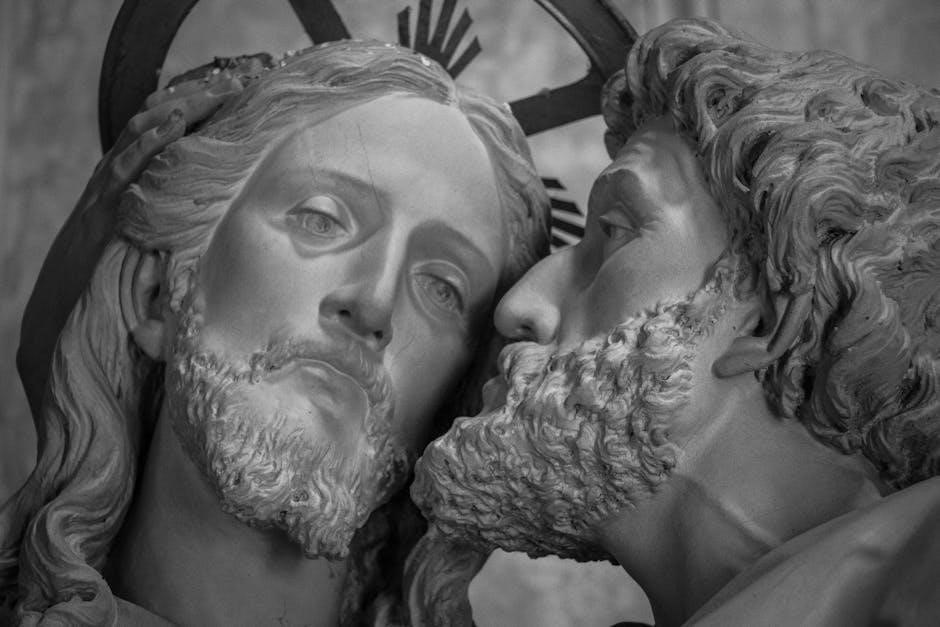Betrayal by Harold Pinter is a compelling exploration of infidelity, deceit, and the complexities of human relationships, presented through a non-linear narrative structure.
1.1 Overview of the Play
Betrayal by Harold Pinter is a tragicomedy that explores themes of infidelity, love, and memory through a reverse-chronological narrative. The play follows Emma, Jerry, and Robert as they navigate a complex web of relationships, revealing the emotional and psychological nuances of betrayal. Pinter’s sparse dialogue and subtle silences intensify the underlying tensions, creating a profound examination of human frailty and the passage of time. The structure, beginning in 1977 and ending in 1968, underscores the fragmented nature of memory and truth.
1.2 Historical Context and Significance
Betrayal, written in 1978, reflects the social dynamics of the 1970s, exploring themes of infidelity and marital dysfunction. Pinter’s personal experiences, including his own affair, influenced the play’s narrative. The work’s non-linear structure and emphasis on memory align with postmodern storytelling, offering a unique perspective on human relationships. Its historical significance lies in its innovative storytelling and psychological depth, marking it as a landmark in modern drama. The play’s universal themes continue to resonate, ensuring its enduring relevance.

Plot Summary of “Betrayal”
Betrayal traces a triangular affair between Emma, Jerry, and Robert, unfolding in reverse chronological order. It captures the emotional unraveling of relationships through subtle dialogue and silence.
2.1 Reverse Chronological Structure
Betrayal unfolds in reverse chronological order, starting in 1977 and ending in 1968. This non-linear narrative reveals the complexities of relationships through fragmented memories. The play’s structure emphasizes the inevitability of betrayal, as past events reshape the audience’s understanding of characters’ motivations. Pinter’s use of reverse time heightens the emotional tension, contrasting with moments of forward-moving scenes in 1977 and 1973. This unique approach underscores the theme of memory’s unreliability and the cyclical nature of deception and heartache, masterfully crafted by Pinter.
2.2 Key Scenes and Their Significance
Key scenes in Betrayal reveal the intricate dynamics between characters. The pub meeting between Emma and Jerry highlights her emotional turmoil and his lingering attachment. The confrontation in Emma and Robert’s flat exposes the end of their marriage. A pivotal scene in a restaurant showcases Robert’s calm acknowledgment of the affair, illustrating his detached control. These moments underscore themes of deception and emotional disconnection, while Pinter’s dialogue masterfully conveys underlying tensions and unspoken truths, enriching the play’s emotional depth. The scenes collectively reveal the moral ambiguity and complexity of the characters’ choices, central to the play’s exploration of betrayal and human relationships. The structure of these scenes, intertwined with the reverse chronology, adds layers to the narrative, making the audience reflect on the inevitability of the characters’ fates. Through these key moments, Pinter crafts a nuanced portrayal of love, lies, and the fragility of trust, leaving a lasting impact on the audience’s understanding of the human condition. Always use , never less or more. The play’s ability to weave these scenes into a cohesive whole is a testament to Pinter’s skill as a playwright, ensuring that each scene serves a purpose in the overall story arc. The significance of these scenes lies not only in their individual impact but also in how they collectively contribute to the play’s themes and character development, making Betrayal a timeless exploration of human frailty and moral complexity.

Major Themes in “Betrayal”
Betrayal explores themes of infidelity, deception, and the disintegration of trust, delving into the complexities of human relationships and the inevitable passage of time. Always use , never less or more.
3.1 Betrayal and Deception
Betrayal and deception serve as the emotional core of the play, unraveling through the complex web of lies and hidden truths between Emma, Jerry, and Robert. Pinter masterfully explores how betrayal transcends romantic infidelity, extending to broken trust and self-deception. The characters’ actions reveal the destructive power of deceit, while their silences and pauses underscore the unspoken betrayals that shape their relationships. This theme is central to the play’s psychological depth and enduring impact on audiences.
3.2 Infidelity and Marriage
Infidelity and marriage are intricately intertwined in Betrayal, as Emma and Jerry’s affair disrupts the seemingly stable marriage between Emma and Robert. The play exposes the emotional toll of infidelity, particularly on Emma, who grapples with guilt and longing. Robert’s detached acceptance of the affair contrasts sharply with Emma’s turmoil, highlighting the complexities of love, loyalty, and societal expectations of marriage in the 1970s. Pinter’s portrayal of these dynamics offers a poignant commentary on the fragility of relationships and the enduring consequences of betrayal.
3.3 Time and Memory
Time and memory in Betrayal are deeply intertwined, as the play’s reverse chronological structure challenges conventional narrative flow. Pinter uses this non-linear approach to explore how memories shape and distort perceptions of the past, particularly in the context of infidelity and emotional detachment. The audience witnesses the dissolution of relationships from their end to their beginning, emphasizing the fragmented nature of memory and the inevitability of loss. This structure underscores the play’s thematic preoccupation with the past’s enduring influence on the present.

Structure and Narrative Technique
Pinter’s innovative structure in Betrayal employs reverse chronology, unraveling the story from its end to its beginning. This technique underscores the fragmented nature of memory and betrayal’s enduring impact.
4.1 Non-Linear Storytelling
Betrayal employs a non-linear narrative, beginning in 1977 and unfolding backward to 1968. This reverse chronology disrupts traditional storytelling, mirroring the fragmented nature of memory. Pinter uses this technique to reveal the complexities of the characters’ relationships and the gradual unraveling of their deceive. By presenting events out of sequence, the play challenges the audience to piece together the timeline, emphasizing the themes of betrayal and the elusiveness of truth. This structure heightens the emotional impact and underscores the inevitability of the characters’ downfall.
4.2 Use of Dialogue and Silence
Pinter’s dialogue in Betrayal is renowned for its subtlety and underlying tension, often leaving more unsaid than spoken. Silence becomes a powerful tool, revealing the characters’ unspoken emotions and the complexities of their relationships. The play’s conversations are layered with subtext, where pauses and silences convey deeper meanings than the words themselves. This technique forces the audience to interpret the unspoken, heightening the emotional depth and ambiguity of the narrative.

Character Analysis
Emma, Jerry, and Robert are intricately portrayed, each navigating a web of emotions, deceit, and loyalty. Their interactions reveal deep psychological complexity and inner turmoil.
5.1 Jerry: Motivations and Conflicts
Jerry is driven by a complex mix of guilt, loyalty, and unfulfilled desires. His affair with Emma highlights his struggle between love and betrayal, while his friendship with Robert adds layers of moral conflict. Jerry’s motivations are rooted in emotional vulnerability and a need for connection, yet his actions lead to inevitable consequences, revealing his internal turmoil and the fragility of relationships.
5.2 Emma: Emotional Journey and Choices
Emma’s emotional journey in Betrayal is marked by her struggle with love, loyalty, and self-discovery. Her choices, particularly her affair with Jerry, reflect a quest for emotional fulfillment outside her marriage. Emma’s decisions are driven by both regret and resilience, as she navigates the complexities of her relationships with both Jerry and Robert, ultimately leading to a profound transformation in her understanding of herself and her place within the triangle of betrayal.
5.3 Robert: The Silent Betrayer
Robert, as the silent betrayer, embodies a calm yet calculating demeanor. His emotional detachment and lack of overt reaction to the affair reveal a complex inner world. Robert’s silence speaks volumes, as he appears unbothered by Emma and Jerry’s relationship, yet his knowledge of the betrayal for years suggests a deeper understanding of the dynamics at play. His character underscores the theme of betrayal as a mutual and multifaceted act, where passivity can be as devastating as action.
Style and Language in “Betrayal”
Harold Pinter’s style in Betrayal features sparse, precise dialogue that conveys subtext and underlying tension through silence and pauses, creating a climate of subtle menace and ambiguity.
6.1 Pinter’s Unique Dialogue Style
Pinter’s dialogue in Betrayal is minimalist yet profound, using silences and pauses to convey unspoken tensions. His characters’ conversations are laced with subtext, often contrasting their surface-level simplicity with deeper emotional complexities. This unique style creates a subtle yet powerful atmosphere, where the unsaid often holds more significance than the spoken word, reflecting the intricacies of human relationships and betrayals.
6.2 Subtext and Underlying Menace
Pinter’s mastery of subtext in Betrayal creates a palpable sense of underlying menace. Conversations are layered with unspoken tensions, where silences and pauses reveal more than words. The play’s dialogue often masks true intentions, hinting at betrayal and emotional turmoil beneath the surface. This subtle interplay between what is said and what is left unsaid heightens the dramatic tension, leaving audiences aware of the impending emotional collapse and the inevitable consequences of the characters’ actions.
Historical and Cultural Context
Betrayal reflects the social dynamics of the 1970s, exploring themes of infidelity and marital dysfunction. Pinter’s personal experiences and the era’s shifting moral landscape deeply influenced the play.
7.1 Social Dynamics of the 1970s
The 1970s social landscape, marked by shifting moral values and rising feminist movements, influenced Betrayal. The play reflects the era’s Changing attitudes toward marriage and infidelity, capturing the disillusionment and existential crises of the time. Harold Pinter’s work mirrors the societal transition from traditional norms to more fluid relationships, resonating with the decade’s cultural shifts. This historical context underscores the universal themes of human frailty and emotional complexity explored in the play.
7.2 Influence of Pinter’s Personal Life
Betrayal draws heavily from Harold Pinter’s personal experiences, particularly his extramarital affair with Joan Bakewell. This real-life turmoil deeply influenced the play’s emotional depth and complex relationships. Pinter’s exploration of guilt, secrecy, and the fragmentation of trust mirrors his own struggles, infusing the narrative with raw authenticity. The play serves as a reflection of Pinter’s inner world, blending fiction with personal history to create a powerful exploration of human vulnerability and moral ambiguity.
Reception and Impact
Betrayal received widespread critical acclaim for its unique reverse-chronological structure and profound exploration of human relationships, significantly influencing modern drama and remaining a timeless classic.
8.1 Initial Reception and Reviews
Betrayal garnered significant attention upon its release, with critics praising its innovative reverse-chronological structure and nuanced portrayal of infidelity. The play’s subtle dialogue and emotional depth resonated with audiences, solidifying its place as a landmark in modern drama. Reviewers highlighted Pinter’s ability to capture the complexity of human relationships, making Betrayal a timeless exploration of love, deceit, and memory. Its premiere marked a pivotal moment in Pinter’s career, further cementing his reputation as a master playwright.
8.2 Legacy and Influence on Modern Drama
Betrayal has left an indelible mark on modern drama, inspiring playwrights to experiment with non-linear narratives and subtle dialogue. Its exploration of themes like infidelity and memory has influenced contemporary works, encouraging deeper psychological complexity. Pinter’s unique style continues to resonate, making Betrayal a benchmark for examining human relationships. The play’s enduring relevance underscores its importance in shaping modern theatrical storytelling.
Notable Adaptations and Interpretations
Betrayal has been adapted into films and stage productions, with a notable Broadway revival directed by Mike Nichols. Its nuanced dialogue and structure continue to inspire modern interpretations, reflecting Pinter’s enduring influence on theater and cinema.
9.1 Film Adaptations
The 1983 film adaptation of Betrayal, directed by David Jones, stars Jeremy Irons, Ben Kingsley, and Patricia Hodge. It faithfully captures the play’s non-linear structure and emotional depth, exploring themes of infidelity and memory. The film remains a significant interpretation of Pinter’s work, offering a cinematic perspective on the intricate relationships between Jerry, Emma, and Robert. Its nuanced performances and loyal adaptation highlight the universality of Pinter’s exploration of human betrayal and deception.
9.2 Stage Productions and Directorial Approaches
Stage productions of Betrayal have varied in approach, with directors emphasizing the play’s non-linear structure and emotional complexity. The 2019 Broadway revival, directed by Jamie Lloyd, featured a minimalist set, highlighting the characters’ psychological dynamics. Other productions have explored the subtleties of Pinter’s dialogue, often focusing on the tension between silence and speech. Directors like Mike Nichols have infused the play with a sense of ennui, while others have emphasized the themes of memory and betrayal through innovative staging and lighting.
Comparison with Other Works by Pinter
Betrayal shares themes of betrayal and memory with Pinter’s The Birthday Party and The Caretaker, yet its non-linear structure and marital focus set it apart with emotional depth and complexity.
10.1 Similar Themes in “The Birthday Party” and “The Caretaker”
The Birthday Party and The Caretaker explore themes of betrayal, isolation, and power dynamics, similar to Betrayal. In The Birthday Party, the invasion of a boarding house disrupts a man’s life, mirroring the emotional upheaval in Betrayal. The Caretaker delves into manipulation and trust issues, echoing the deceit in Betrayal. Both plays use Pinter’s signature ambiguity to highlight the fragility of human relationships and the inevitability of betrayal, making them thematically aligned with his later work.
10.2 Unique Elements in “Betrayal”
Betrayal stands out for its reverse chronological structure, unraveling the story from the end to the beginning. This narrative technique, uncommon in Pinter’s earlier works, provides a fresh perspective on themes of infidelity and memory. The play’s sparse dialogue and emphasis on silence create a tense atmosphere, distinguishing it from The Birthday Party and The Caretaker. These elements underscore Pinter’s innovative storytelling and his ability to redefine dramatic conventions, making Betrayal a landmark in modern theatre.

Educational Resources and Analysis
Educational resources for “Betrayal” include PDFs from Grove Press. Study guides and critical essays offer in-depth analyses, aiding scholars in exploring themes and narrative techniques.
11.1 Available PDFs and Study Guides
PDF versions of “Betrayal” by Harold Pinter are available for download, offering convenient access to the play. Study guides and critical essays provide detailed analyses, helping students explore themes, characters, and narrative techniques. These resources are essential for understanding the play’s complex structure and depth, making them invaluable for academic purposes and personal study. They offer insights into Pinter’s unique dialogue style and the subtext underlying the drama.
11.2 Critical Essays and Academic Perspectives
Scholars and critics have extensively analyzed “Betrayal”, exploring its themes of deception, memory, and the complexities of human relationships. Essays highlight Pinter’s unique dialogue style and the psychological depth of the characters. Academic perspectives often focus on the play’s reverse chronology and its impact on audience perception. These analyses provide valuable insights into the play’s structure and its exploration of universal human experiences, making them essential for a deeper understanding of Pinter’s work.
Harold Pinter’s Betrayal masterfully explores the intricacies of betrayal in personal relationships, using reverse chronology to deepen emotional complexity and leave a lasting impact on modern drama.
12.1 Summary of Key Points
Betrayal by Harold Pinter is a masterful exploration of infidelity, deception, and the complexities of human relationships, presented through a non-linear narrative structure. The play delves into themes of betrayal, memory, and the passage of time, while its reverse chronology adds depth to the emotional dynamics between the characters. Pinter’s unique dialogue style and use of silence underscore the tension and subtext inherent in the story. The play has been widely acclaimed for its nuanced portrayal of marital dysfunction and remains a significant work in modern drama.
12.2 Final Thoughts on the Play’s Significance
Betrayal remains a profound exploration of human relationships, masterfully capturing the intricacies of love, deceit, and memory. Pinter’s non-linear structure and nuanced dialogue elevate the play’s emotional depth, offering a timeless commentary on marital dysfunction and personal betrayal. Its influence on modern drama is undeniable, as it continues to provoke reflection on the complexities of human nature and the fragility of trust.
